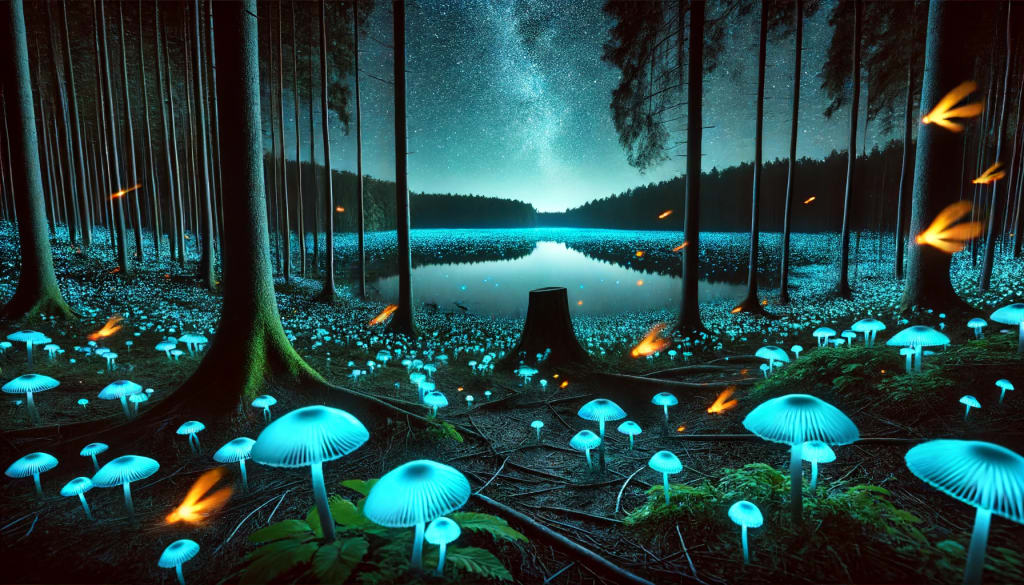The Fascinating World of Bioluminescence: Nature's Living Lights
Exploring the Enchanting Glow of Life in the Deep Sea, Forests, and Beyond

Bioluminescence, the production and emission of light by living organisms, is one of nature's most mesmerizing phenomena. This natural wonder can be found in various ecosystems, from the deep sea to dense forests, and across a wide range of species including bacteria, fungi, insects, and marine animals. Let's delve into the captivating world of bioluminescence, exploring its causes, examples, and the roles it plays in nature.
The Science Behind Bioluminescence
At its core, bioluminescence is a biochemical reaction. It typically involves a light-emitting molecule called luciferin and an enzyme called luciferase. When luciferin reacts with oxygen, catalyzed by luciferase, light is produced. This light can vary in color depending on the organism and the specific type of luciferin and luciferase involved. The reaction is remarkably efficient, with nearly all the energy produced being converted into light rather than heat.
Marvels of the Deep Sea

The deep sea is perhaps the most renowned stage for bioluminescence. In this dark abyss, where sunlight cannot penetrate, many marine creatures have evolved to produce their own light. Among the most famous are the anglerfish, which uses a bioluminescent lure to attract prey, and the comb jelly, which displays beautiful, multicolored light patterns as it moves through the water. These light displays serve various purposes, such as attracting mates, deterring predators, and facilitating hunting.
One of the most spectacular displays of bioluminescence in the ocean is the "milky seas" phenomenon. This rare event occurs when vast areas of the ocean's surface glow brightly at night. The cause is thought to be bioluminescent bacteria, specifically Vibrio harveyi, which can form massive colonies. Sailors have reported these luminous seas for centuries, describing them as eerily beautiful.
Terrestrial Glows
Bioluminescence is not confined to the ocean. On land, it is most commonly seen in fireflies, which use their light for communication, particularly during mating rituals. Each firefly species has a unique light pattern, allowing males and females to recognize each other. The glow of fireflies has enchanted humans for centuries, inspiring countless myths and legends.
Another terrestrial example is found in fungi. Certain species of fungi, such as the "foxfire" or "fairy fire" mushrooms, emit a soft, greenish light. This bioluminescence is thought to attract insects that help disperse the fungi's spores, aiding in reproduction. While the glow is usually faint, it can be quite striking in dense forests devoid of artificial light.
Bioluminescence in Microorganisms
Even microorganisms can exhibit bioluminescence. For example, the single-celled dinoflagellates, which are found in both marine and freshwater environments, can produce stunning displays of light. When disturbed, these tiny organisms emit a blue-green light, creating the effect of sparkling water. This phenomenon, often seen in coastal areas, is popularly referred to as "sea sparkle."
The Functions and Benefits of Bioluminescence
Bioluminescence serves several important functions in the natural world. For many organisms, it is a vital tool for survival and reproduction. Some of the key roles of bioluminescence include:
Attracting Mates: As seen in fireflies, bioluminescent signals are often used to attract potential mates, ensuring the continuation of the species.
Camouflage: Certain marine organisms, like the hatchetfish, use bioluminescence to blend in with the faint light filtering down from above, making them less visible to predators.
Predator Avoidance: Some species, such as the Hawaiian bobtail squid, have bioluminescent bacteria that help them create a form of counter-illumination, reducing their shadow and making them less conspicuous to predators.
Luring Prey: Predators like the anglerfish use bioluminescent lures to attract unsuspecting prey into striking distance.
Communication: In addition to mating signals, bioluminescence can be used for other forms of communication, such as signaling danger or coordinating group behaviors.
Bioluminescence and Humans
Humans have long been fascinated by bioluminescence, and it has inspired various cultural, artistic, and scientific pursuits. In modern science, researchers are exploring ways to harness bioluminescence for practical applications. For example, bioluminescent markers are used in biomedical research to track the activity of cells and molecules in real-time. There is also ongoing research into using bioluminescent organisms for environmental monitoring, such as detecting pollutants in water.
In addition to its scientific applications, bioluminescence has inspired a sense of wonder and beauty, reminding us of the incredible diversity and creativity of life on Earth. Whether it’s the gentle glow of a firefly on a summer night or the dazzling display of a bioluminescent bay, these natural lights continue to captivate and inspire.
Conclusion
Bioluminescence is a testament to the ingenuity of nature. This fascinating phenomenon, which has evolved independently in various organisms, serves as a crucial survival tool and a source of beauty. By studying and understanding bioluminescence, we not only gain insights into the natural world but also find inspiration for new scientific and technological innovations. So next time you encounter a glowing creature, take a moment to appreciate the marvel of bioluminescence and the extraordinary life forms that illuminate our world.
About the Creator
Laura Magdalena
Welcome! I write about a little bit of everything, but I'm passionate about exploring technology, with a special focus on AI. Dive into my insights to discover how these fields are transforming our world and shaping the future!
Enjoyed the story? Support the Creator.
Subscribe for free to receive all their stories in your feed. You could also pledge your support or give them a one-off tip, letting them know you appreciate their work.






Comments
There are no comments for this story
Be the first to respond and start the conversation.